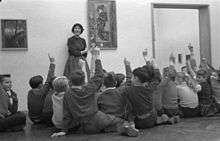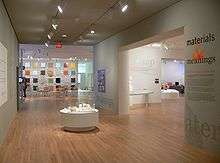Museum education

Museum Education is a specialized field devoted to developing and strengthening the education role of non-formal education spaces and institutions such as museums. Its main objective is to engage visitors in learning experiences to enhance their curiosity and interest on their objects and collections.

In a seminal report called Excellence and Equity[1] published in 1992 by the American Association of Museums (now the American Alliance of Museums), the educational role of museums was identified as the core to museums' service to the public. According to the report, "...the public dimensions of museums leads them to perform the public service of education - a term that in its broadest sense includes exploration, study, observation, critical thinking, contemplation and dialogue." As museum education has developed as a field of study and interest in its own right, efforts have been made to record its history and to establish a research agenda to strengthen its position as a discipline in the wider work of museums.
History
Non-formal Education
In his first report as the first Assistant Secretary of State for Education and Culture during John F. Kennedy’s administration, in 1968, Philip H. Coombs emphasized the increment of the educative needs of the world’s population after World War II. In it, he mentions the diversity of non-formal education activities that constitute, or should constitute an important complement to formal education to the total educational efforts of any country.[2] To Coombs, non-formal education had the potential to satisfy the learning demands of both, individuals and collectivities, because unlike formal and traditional education, which is rigid with its contents and programs, it is flexible and, when planning and designing educational activities, it takes into consideration local variations of culture, economy and society, which counteracts the tendency of developing countries to just imitate education models of developed countries.[3]
In a work written by Coombs in conjunction with M. Ahmed, non-formal education is defined as «...any organized educational activity outside the established formal system —whether operating separately or as an important feature of some broader activity— that is intended to serve identifiable learning clienteles and learning objective».[4] Afterwards, Coombs and Ahmed add the idea that non-formal education is any systematic educative activity, organized outside from the official framework to facilitate educative experiences for all people, regardless of age, genre, nationality, social, economic or health situation.[2] Throughout his career, Coombs encouraged and impulsed the professional development of people responsible of non-formal education, which will be determining to the development and professionalization of the educative areas in institutions devoted to non-formal education.
Beginnings of Museum Education in Art Museums of the United States
At the turn of the twentieth century, art museums were very new institutions to the average visitor, who was seen wandering with no clear direction through the galleries, and with no clear idea on how to appreciate and study the exhibitions. In 1906, architect J. Randolph Coolidge Jr. was appointed the temporary director of the Boston Museum of Fine Arts. He experimented with a guiding system in the galleries, to help visitors orient themselves throughout their walk across the exhibitions.[5]
An article published in the June bulletin of the museum that same year, features one of the first uses of the term docent and the description of its functions:
"It has been proposed to the Trustees to consider the permanent appointment of one or more persons of intelligence and education who could act as intermediaries between Curators and the many who would be glad to avail themselves of trained instruction in our galleries. Through these docents, as it has been proposed to call them, the heads of departments could instruct many more persons than it would be possible for them to accompany through the galleries; and illustrated lectures upon the collections prepared in the departments might be regularly given by these specially qualified aids both in the Museum and in the class rooms of neighboring schools and colleges."[6]
Publications
Excellence in Practice: Museum Education Principles and Standards[7] was developed by the Education Committee of the American Association of Museums to help guide and inform the practice of Museum Education. The Journal of Museum Education (JME)[8] is a journal covering the theory, training and practice of the museum education field from the Museum Education Roundtable.[9] Articles are written by museum, education, and research professionals. The Museum Education Monitor[10] is a monthy email newsletter that tracks and records research and resources in museum education world wide. Art Museum Teaching[11] is a digitally published resource and collaborative online forum for reflecting on issues of teaching, learning, and experimental practice in the field of art museum education. The Journal of Museum Studies[12] is an independent, not-for-profit publication dedicated to creating and preserving digital archive of scholarly articles in the field of museum studies.
See also
References
- ↑ Excellence and Equity. American Association of Museums. 1992. ISBN 978-0-931201-14-1.
- 1 2 Pastor Homs, Ma. Inmaculada (2001). «La necesidad de planificación y evaluación educativas en la educación no formal. Algunas propuestas». Educació i Cultura: 14, 87-89.
- ↑ Pastor Homs, Ma. Inmaculada (2011 [2004]). «1». Pedagogía museística. Nuevas perspectivas y tendencias actuales. Ariel. p. 15. ISBN 978-84-344-6974-7.
- ↑ Coombs, Phillips H. and H. Ahmed. New Paths To Learning: For Rural Children and Youth (en inglés). New York, N.Y.: International Council for Educational Development Publications. p. 11.
- ↑ Burnham, Rika and, Elliot Kai-Kee (2011). «2». Teaching in the Art Museum. Interpretation as Experience(en inglés). J. Paul Getty Museum, Los Angeles. ISBN 978-1-60606-058-2.
- ↑ "Full text of "The Educational Work of the Museum. Retrospect and Prospect"". archive.org. Retrieved 2016-06-13.
- ↑ Excellence in Practice: Museum Education Principles and Standards (PDF). EdCom, American Association of Museums.
- ↑ JME: The Journal of Museum Education. Museum Education Roundtable. ISSN 1059-8650.
- ↑ Museum Education Roundtable website.
- ↑ Castle, Chris. "Museum Education Monitor". Retrieved 29 February 2012.
- ↑ Art Museum Teaching
- ↑ Journal of Museum Studies
Art Museum Teaching http://artmuseumteaching.com/ Museum Education Roundtable http://museumeducation.info/
External links
- Museum-Ed, an online organization devoted to meeting the needs of museum educators by providing tools and resources by and for the museum education community
- The Museum Education Roundtable, publisher of the Journal of Museum Education
- New York City Museum Educators Roundtable, a forum for museum education professionals to address issues of museum and educational interest, exchange and disseminate relevant information and to explore and implement cooperative programming opportunities through roundtable discussions, workshops, and an annual conference.
- Art Museum Teaching, a digital community and collaborative online forum for reflecting on issues of teaching, learning, and experimental practice in the field of art museum education. The site's goal is to connect educators, ideas, and resources around a dialogue about shared practice in teaching and learning.